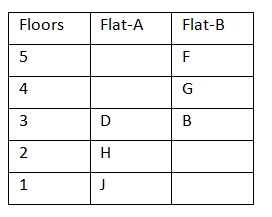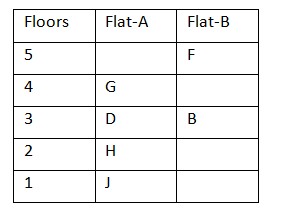Question
Who lives immediately above E in the same type of
flat? Answer the questions based on the information given below: Ten persons (A, B, C, D, E, F, G, H, I and J) live on 10 different flats of a 5 storey building, where the bottommost floor is 1 and the floor above is 2 and so on. There are 2 types of flats on each floor, flat A and flat B such that flat A is in the west of flat B. Flat A of floor 1 is immediately below of flat A of floor 2, which is immediately below of flat A of floor 3 and so on, similarly for flat B. The dimensions of each of the flats is same There are two floors between the floors of J and G (both of them may or may not live in the same type of flat). J lives on first floor. J lives south west of B. F lives 2 floors above B (both live in the same type of flat). D lives immediately above floor H, who doesn’t live anywhere below B’s floor. A lives above D’s floor but not in flat A. E doesn’t live on a prime numbered floor. C doesn’t live immediately above B.Solution
There are two floors between the floors of J and G (both of them may or may not live in the same type of flat). J lives south west of B. J lives on first floor. F lives 2 floors above B (both live in the same type of flat). D lives immediately above H, who doesn’t live below anywhere B’s floor. So, G must live above J’s floor either in flat A or B. Both F and B live in flat B. Case 1: When G lives in the flat B.  Case 2(a): When both G and J live in the same flat and J lives on 1st floor. H doesn’t live below B’s floor, so this case is not possible.
Case 2(a): When both G and J live in the same flat and J lives on 1st floor. H doesn’t live below B’s floor, so this case is not possible.  A lives above D’s floor but not in flat A. E doesn’t live in a prime numbered floor. C doesn’t live immediately above B. So, A lives in on 5th floor in flat B. Case 2(b): When both G and J live in the same flat and J live on 1st floor. The final arrangement is as follows:
A lives above D’s floor but not in flat A. E doesn’t live in a prime numbered floor. C doesn’t live immediately above B. So, A lives in on 5th floor in flat B. Case 2(b): When both G and J live in the same flat and J live on 1st floor. The final arrangement is as follows: 
If a person walks 25% more than of his usual speed, reaches his distance 90 minutes before. If the destination is 217.5 km away, then the usual speed of...
Arjun left a bus stop at 14 m/s. Mohan started chasing him 7 seconds later and overtook him in 28 seconds. What speed was Mohan running at?
Gagan traveled a certain distance at his regular speed. If he had increased his speed by 20 km/h, he would have taken 2 hours less to complete the journ...
A and B are travelling towards each other with a speed of 15 km/hr and 25 km/hr. They started at same time and A covered 30 km less distance than B befo...
Excluding the Stoppages i.e. Non-stop, the speed of a Bullet train is 540 kmph and including the stoppages, it is 450 kmph. Calculate for how many minut...
A wheel has a diameter of 28 meters and rotates at a speed of 25 revolutions per minute. How much distance will the wheel travel in 32 minutes?
If the speed ratio of A, B and C while covering the same distance is 7 : 3 : 1 then find the ratio of time taken by them.
Sheila walks at the speed of her usual speed (20/21) and determines a clear distance in eight minutes more than the time it takes in normal speed. Calcu...
The speed of ‘A’ and ‘B’ is 30 km/hr and 12 km/hr, respectively. If the distance covered by ‘A’ in ‘x’ hours is 360 km more than that by...
Due to fog, the speed of a train was reduced to (2/3)rd of its original speed, resulting in a delay of 45 minutes. Find the usual time taken ...
Relevant for Exams:


